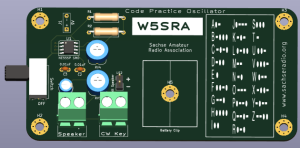Difference between revisions of "CW Practice Oscillator Kit"
| Line 3: | Line 3: | ||
[[File:3D-CW-Code-Practice-Osc.PNG |300px ]] | [[File:3D-CW-Code-Practice-Osc.PNG |300px ]] | ||
| + | I decided to make a CW practice board for Morse Code training for my local HAM club. I have donated all 10 boards to the club. | ||
| + | It was a simple process to use KiCad 7.0 to design the board.<br> | ||
| + | I am not going to explain how to use KiCad in this wiki page since I have other wiki pages explaining how to use KiCad. | ||
This project uses a NE555 timer SMD SOIC-8 Chip that produces a square wave that can be adjusted between 300Hz and 1KHz <br> | This project uses a NE555 timer SMD SOIC-8 Chip that produces a square wave that can be adjusted between 300Hz and 1KHz <br> | ||
| + | RV4 is a 200K ohm variable resistor that control the tone between 300Hz to 1KHz. | ||
| + | It is made to be adjustable for the user to change to the tone they prefer. | ||
| + | RV3 is a 100 Ohm variable resistor that controls the volume. | ||
| + | |||
| + | The CW key is connected to a Terminal block that is label CW Key | ||
Revision as of 03:30, 23 February 2024
I decided to make a CW practice board for Morse Code training for my local HAM club. I have donated all 10 boards to the club. It was a simple process to use KiCad 7.0 to design the board.
I am not going to explain how to use KiCad in this wiki page since I have other wiki pages explaining how to use KiCad. This project uses a NE555 timer SMD SOIC-8 Chip that produces a square wave that can be adjusted between 300Hz and 1KHz
RV4 is a 200K ohm variable resistor that control the tone between 300Hz to 1KHz. It is made to be adjustable for the user to change to the tone they prefer. RV3 is a 100 Ohm variable resistor that controls the volume.
The CW key is connected to a Terminal block that is label CW Key
